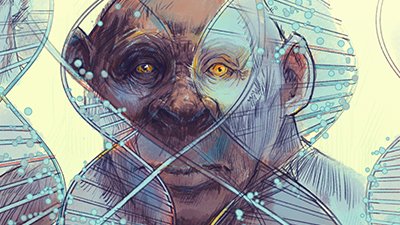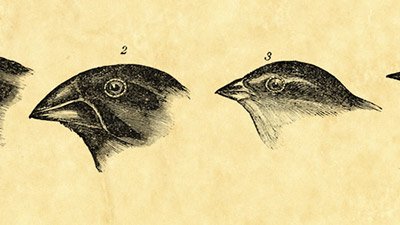
BBC News: “Mouse Set to be ‘Evolution Icon’”
Peppered moths, move over! There’s a new alleged “icon of ‘evolution in action’” in town.
News Source
- BBC News: “Mouse Set to be ‘Evolution Icon’”
Reporting in Science, Harvard biologist Catherine Linnen and colleagues describe the “rapid adaptation under ecological pressure” of pale deer mice living in the sand dunes of Nebraska.1
The pale coat color comes from “variation [in] a gene that already exists, rather than [in] a new type of gene altogether.”
Usually deer mice, which are common in North America, have a dark coat. That helps them blend in with the dark soil and escape the notice of overhead predators, such as owls and hawks. The mice just outside of Nebraska’s Sand Hills sport dark fur, too. But living among the Sand Hills are mice with a pale coat, a “striking contrast,” said Linnen, to the dark-furred mice elsewhere. Of course, this helps the mice blend in with their lighter-colored Sand Hills background.
The scientists conducted an investigation to determine the gene (called the Agouti gene) that codes for the light-colored coat. In their paper’s abstract, they report:
We studied cryptically colored deer mice living on the Nebraska Sand Hills and show that their light coloration stems from a novel banding pattern on individual hairs produced by an increase in Agouti expression caused by a cis-acting mutation (or mutations), which either is or is closely linked to a single amino acid deletion in Agouti that appears to be under selection.
Thus, as BBC News reports, the pale coat color comes from “variation [in] a gene that already exists, rather than [in] a new type of gene altogether.” It could even be that the entire variation is due to the deletion of a single amino acid described by the authors. Creationists can interpret this finding in one of two ways:
- It is possible that the increased expression of the Agouti gene that leads to the pale coat color is not a mutation at all, but rather one variation that existed in the ancestors of the deer mouse—its ancestral created kind. If this is the case, natural selection has merely favored one pre-existing variation over another. Of course, evolutionists cannot accept such a possibility; for them, all genetic variation must ultimately be due to mutations somewhere along the line. (As it is, however, we would consider this possibility less likely due to the lack of pale deer mice elsewhere.)
- The other possibility is that the increased expression of the Agouti gene is, indeed, due to a mutation (specifically, the single amino acid deletion). But if so, it is a mutation of the opposite sort than what molecules-to-man evolution would require, because it results in the deletion of an amino acid. (While, in this case, the ultimate result is simply a lighter coat color, in other cases such deletions may have more deleterious effects.) Furthermore, even if the mutation resulted in the addition of an amino acid, that would not be evidence of the wide-scale genetic changes molecules-to-man evolution would require (new genes and new genetic information—not just random changes).
That process of adaptation could never result in one organism turning into another.
Additionally there is the issue of the timing of this genetic mutation (if, indeed, it was a mutation). According to Linnen, “We were also intrigued by the fact that Sand Hills had formed within the last 8,000 to 15,000 years, which implies the light color of the Sand Hills mice became advantageous only recently.” Based on estimates of mutation rates, the scientists concluded the genetic variation for pale fur originated around 4,000 years ago.
To evolutionists, the appearance and spread of a mutation in four millennia is “rapid.” And although there are other examples of rapid change within a single species in only decades (see, e.g., “Island Evolves Lizards”), the deer mouse variation has been traced to an actual genetic difference—whereas others (as in the example provided) may more likely be due to non-genetic factors. (Of course, even the evolutionary estimate of 4,000 years—if accurate—fits into the creationist framework.)
This study also reaffirms the potency of natural selection (an important biological concept). The authors say the lighter-colored fur gives the pale mice a 0.5 percent survival advantage in the Sand Hills—which may not sound like much, but as study coauthor Hopi Hoekstra (also a Harvard University biologist) explained, “It doesn’t seem that much, but multiplied over thousands of individuals over hundreds of years, it makes a huge difference.”
So while the deer mouse is poised to become a new icon of evolution, the entirety of this study is easily understandable from the creation paradigm: natural selection is acting on a genetic difference (likely a mutation) that has not increased the quantity of genetic information in the deer mouse. That process of adaptation, even if it continued for eons, could never result in one organism turning into another (i.e., by the generation of novel genetic information and anatomical features), as Darwinian evolution (a.k.a. molecules-to-man evolution) requires.
(For an in-depth analysis of a similar study a few years back, we recommend an article by our staff geneticist Dr. Georgia Purdom, “Evolution or Adaptation?”)
Further Reading
- Life: Designed by God to Adapt
- Is Natural Selection the Same Thing as Evolution?
- Get Answers: Information Theory, Mutations, Natural Selection, and Speciation
For More Information: Get Answers
Remember, if you see a news story that might merit some attention, let us know about it! (Note: if the story originates from the Associated Press, FOX News, MSNBC, the New York Times, or another major national media outlet, we will most likely have already heard about it.) And thanks to all of our readers who have submitted great news tips to us. If you didn’t catch all the latest News to Know, why not take a look to see what you’ve missed?
(Please note that links will take you directly to the source. Answers in Genesis is not responsible for content on the websites to which we refer. For more information, please see our Privacy Policy.)
Footnotes
- Catherine R. Linnen, Evan P. Kingsley, Jeffrey D. Jensen, and Hopi E. Hoekstra, “On the Origin and Spread of an Adaptive Allele in Deer Mice,” Science 325, no. 5944 (August 28, 2009): 1095–1098, doi:10.1126/science.1175826.
Recommended Resources

Answers in Genesis is an apologetics ministry, dedicated to helping Christians defend their faith and proclaim the good news of Jesus Christ.
- Customer Service 800.778.3390
- Available Monday–Friday | 9 AM–5 PM ET
- © 2025 Answers in Genesis





